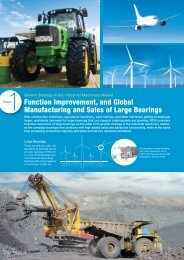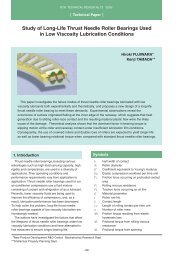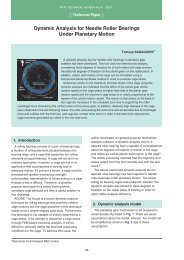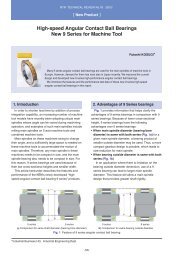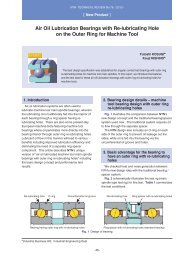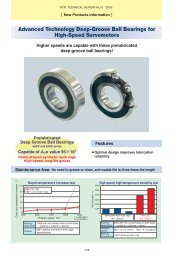Special Issue; Products for Industrial Machinery - NTN
Special Issue; Products for Industrial Machinery - NTN
Special Issue; Products for Industrial Machinery - NTN
You also want an ePaper? Increase the reach of your titles
YUMPU automatically turns print PDFs into web optimized ePapers that Google loves.
Trends in Recent Machine Tool Technologies<br />
4. Ultraprecision Machine Tools<br />
Other than high speed and high efficiency, the most<br />
critical requirement <strong>for</strong> machine tools is high precision.<br />
Recently, various ultraprecision machine tools have<br />
been developed that are significantly more evolved<br />
than earlier high-precision machine tools. Previously,<br />
the industrial fields that required ultraprecision<br />
machine tools were limited and the market scale <strong>for</strong><br />
ultraprecision machine tools was relatively small. In<br />
contrast, needs have been increasingly mounting <strong>for</strong><br />
ultraprecision and micro-machined parts and<br />
components, such as dies <strong>for</strong> optical parts and<br />
components. In response to this trend, development is<br />
in progress <strong>for</strong> various ultraprecision machine tools.<br />
The background <strong>for</strong> the needs <strong>for</strong> ultraprecision<br />
machine tools, supporting technologies <strong>for</strong> their<br />
realization and their advantages are summarized in<br />
Table 3. Progress in the component technologies <strong>for</strong><br />
ultraprecision machinery, such as air hydrostatic<br />
bearings and guides, is remarkable. I believe that<br />
advances in hardware technologies <strong>for</strong> these<br />
mechanical elements are contributing to the higher<br />
Table 3 Background, supporting technologies and<br />
advantages of ultraprecision machine tools<br />
Ultraprecision machine tools<br />
(ultraprecision cutting/grinding machines)<br />
(Background, supporting technologies)<br />
¡Growing needs <strong>for</strong> ultraprecision and micro-machined parts<br />
and components(Optical parts and components, dies, etc.)<br />
¡Sophistication of ultraprecision machine elements (main<br />
spindles, guideways, feed drive systems, etc.)<br />
¡High-precision control technologies<br />
(Advantages)<br />
¡Development of new market segments through ultraprecision-<br />
machining and micro-machining (Satisfaction of needs)<br />
(Optical parts and components, micro parts, mechatronic parts, etc.)<br />
Table 4 Trends in ultraprecision micro machining<br />
1. Form accuracy, finished surface roughness:<br />
¡Micronsnanometers<br />
2. Form (in the case of optical parts)<br />
¡Spherical surfacesaspherical surfacesnonaxisymmetric<br />
surfacesfree-curved surfaces<br />
3. Workpiece materials<br />
¡Soft metals (aluminum, copper, etc.)<br />
¡Hard metals (nickel, hardened steel, etc.)<br />
¡Resin materials, anisotropic materials (lithium niobate, fluorite, etc.)<br />
¡Brittle materials (tungsten carbide, ceramic materials, etc.)<br />
¡Other materials (plastics, etc.)<br />
value of Japanese machine tools.<br />
In the field of ultraprecision-machining and micromachining,<br />
typically <strong>for</strong> the machining of optical parts<br />
and components, the requirements <strong>for</strong> <strong>for</strong>m accuracy<br />
and finished surface roughness have always been<br />
demanding, and the <strong>for</strong>ms of machined parts and<br />
components have become increasingly complicated<br />
as summarized in Table 4. Also, the process <strong>for</strong><br />
preparing optical lenses has changed from injection<br />
molding with plastic materials to a hot-pressing<br />
process with glass. To cope with this trend, an<br />
increasingly larger number of dies are being made of<br />
materials that are extremely difficult to machine, such<br />
as tungsten carbide and ceramics, and these dies<br />
must undergo many machining processes including<br />
grinding and polishing. These techniques in die<br />
machining processes and glass press-<strong>for</strong>ming<br />
processes are contributing positively to the<br />
manufacture of the lenses on camera cell phones and<br />
digital cameras, which are both increasingly common.<br />
Looking more closely at the lenses used in these<br />
types of digital equipment, machining processes that<br />
are more demanding are necessary to realize their<br />
unique optical arrangements. For example, this is<br />
needed to create a combination of a Fresnel lens and<br />
an aspherical lens, which enhances the optical<br />
characteristics of the related optical systems. At the<br />
same time, laser printers and other optical equipment<br />
that utilize lasers need more sophisticated optical<br />
elements that involve nonaxisymmetric or free-curved<br />
surfaces. There<strong>for</strong>e, needs are growing increasingly<br />
<strong>for</strong> more advanced ultraprecision machining<br />
techniques. To this end, I believe that the importance<br />
of ultraprecision machine tools needed <strong>for</strong><br />
ultraprecision-machining and micro-machining will be<br />
further highlighted because they are indispensable in<br />
machining highly sophisticated parts and components<br />
with high added value.<br />
One example of a 3-axis FTS (Fast Tool Servo) 3)<br />
device, which is capable of <strong>for</strong>ming a free-curved<br />
surface with ultra high precision and higher efficiency,<br />
is illustrated schematically in Fig. 4. This device, as<br />
shown in the diagram, machines a workpiece fixed on<br />
a running ultraprecision rotary table while shifting in<br />
the radial direction a tool that has its cutting depth in<br />
three axial directions controlled at high-speeds and<br />
high-response frequencies. If the axial infeed is<br />
controlled while the tool is fed in a radial direction,<br />
then theoretically any intended shape could be <strong>for</strong>med<br />
on the surface of the workpiece.<br />
In reality, however, it is impossible to <strong>for</strong>m a step<br />
square to the cutting direction of a machine tool even<br />
at the maximum possible response frequency and<br />
response speed of the tool. There<strong>for</strong>e, by<br />
-5-




![[New Product] Unit Products for Office Equipment - NTN](https://img.yumpu.com/27154451/1/184x260/new-product-unit-products-for-office-equipment-ntn.jpg?quality=85)
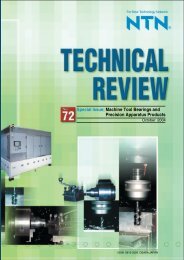
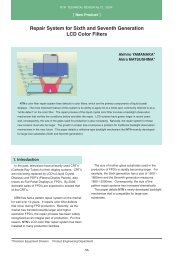
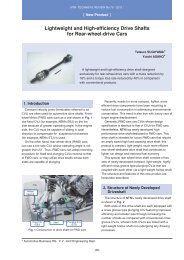
![[New Product] Development of Oil-impregnated Sintered ... - NTN](https://img.yumpu.com/27154427/1/184x260/new-product-development-of-oil-impregnated-sintered-ntn.jpg?quality=85)

